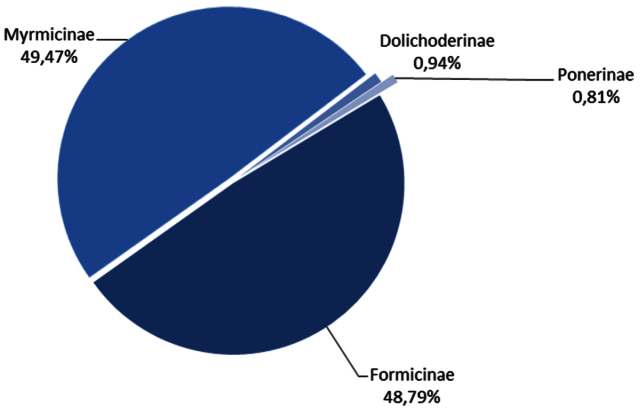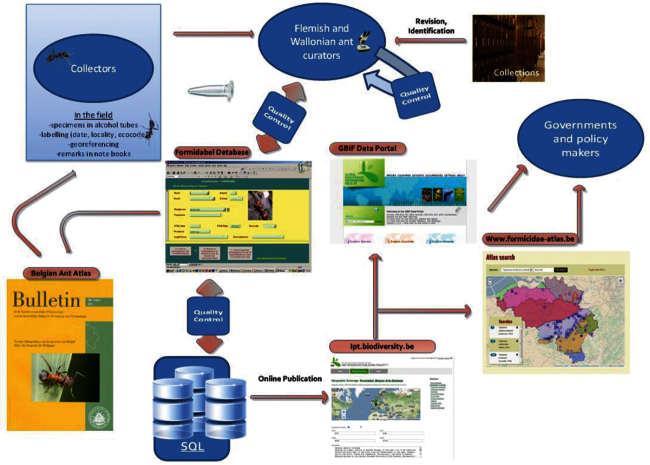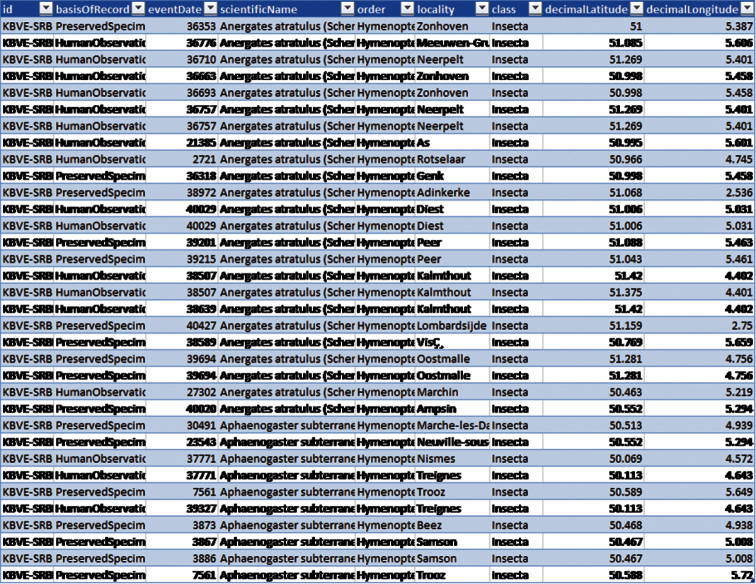Abstract Abstract
FORMIDABEL is a database of Belgian Ants containing more than 27.000 occurrence records. These records originate from collections, field sampling and literature. The database gives information on 76 native and 9 introduced ant species found in Belgium. The collection records originated mainly from the ants collection in Royal Belgian Institute of Natural Sciences (RBINS), the ‘Gaspar’ Ants collection in Gembloux and the zoological collection of the University of Liège (ULG). The oldest occurrences date back from May 1866, the most recent refer to August 2012. FORMIDABEL is a work in progress and the database is updated twice a year.
The latest version of the dataset is publicly and freely accessible through this url: http://ipt.biodiversity.be/resource.do?r=formidabel. The dataset is also retrievable via the GBIF data portal through this link: http://data.gbif.org/datasets/resource/14697
A dedicated geo-portal, developed by the Belgian Biodiversity Platform is accessible at: http://www.formicidae-atlas.be
Purpose: FORMIDABEL is a joint cooperation of the Flemish ants working group “Polyergus” (http://formicidae.be) and the Wallonian ants working group “FourmisWalBru” (http://fourmiswalbru.be). The original database was created in 2002 in the context of the preliminary red data book of Flemish Ants (Dekoninck et al. 2003). Later, in 2005, data from the Southern part of Belgium; Wallonia and Brussels were added. In 2012 this dataset was again updated for the creation of the first Belgian Ants Atlas (Figure 1) (Dekoninck et al. 2012). The main purpose of this atlas was to generate maps for all outdoor-living ant species in Belgium using an overlay of the standard Belgian ecoregions. By using this overlay for most species, we can discern a clear and often restricted distribution pattern in Belgium, mainly based on vegetation and soil types.
Keywords: Formicidae, Belgium, Flanders, Wallonia, Brussels Capital Region, ecological data, grid mapping, UTM, historical data, literature, collections, observations, trapping, ants
Taxonomic coverage
General taxonomic coverage description
The taxonomic coverage (Figure 2) of this database spans the full range of ants pertaining to Belgium (indigenous ant species and exotic introduced species). The determination level is species level and, if appropriate, hybrid level. For some species, information on micro-and macrogynes is available. Key milestones of FORMIDABEL from conception till date are described in the ”Dataset” section of this manuscript.
Figure 2.
Taxonomic range of the FORMIDABEL database subfamilies
Figure 1.
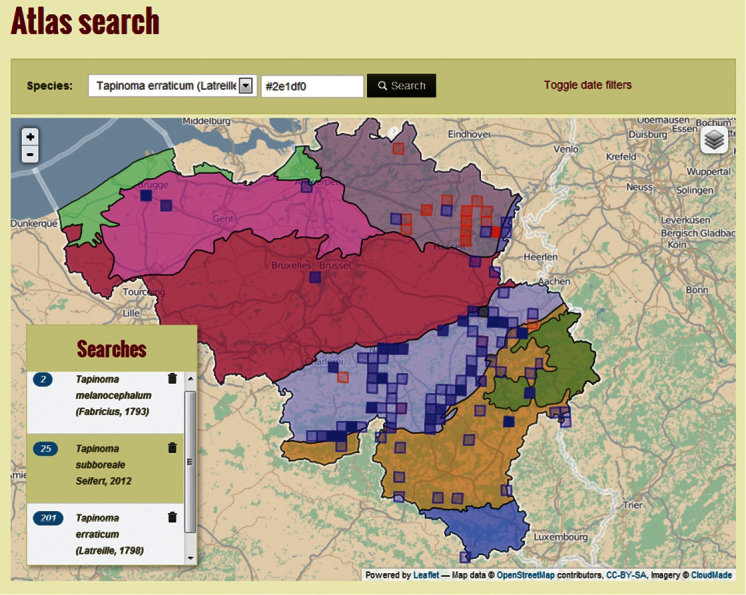
The taxonomic authorities followed are: Radchenko and Elmes (2010) for the genus Myrmica and Seifert (2007) for the other genera. The dataset contains occurrences of 76 native and 9 introduced species.
As depicted in Figure 2, the most abundant subfamily in the database is the Formicinae (49,4%) followed by the Myrmicinae (48,7%), the Dolichoderinae (0,9%) and the Ponerinae (0,8%). The top five most recorded species are Lasius niger (2846 records), Myrmica rubra (2601 records), Myrmica scabrinodis (1626 records), Formica fusca (1467 records) and Myrmica sabuleti (1202 records).
Taxonomic ranks
Phylum: Arthropoda
Subphylum: Hexapoda
Class: Insecta
Order: Hymenoptera
Suborder: Apocrita
Superfamily: Vespoidea
Family: Formicidae
Subfamily: Dolichoderinae, Formicinae, Myrmicinae, Ponerinae
Genera: Anergates, Aphaenogaster, Camponotus, Dolichoderus, Formica, Formicoxenus, Harpagoxenus, Hypoponera, Lasius, Leptothorax, Linepithema, Manica, Monomorium, Myrmecina, Myrmica, Plagiolepis, Polyergus, Ponera, Solenopsis, Stenamma, Strongylognathus, Tapinoma, Technomyrmex, Temnothorax and Tetramorium.
Common names: Ants
Spatial coverage
General spatial coverage
Belgium is a small country in Western Europe. To the west, its 70 km coastline fronts the North Sea; to the north lies the Netherlands; to the east, Germany, and to the south, France and Luxembourg. Biologeographically, the fauna of eastern Belgium belongs to the Central European Province of the Eurasian (Palaearctic) region. By contrast, the rest of the country primarily consists of an Atlantic fauna plus a few Central European relict species.
Politically and geographically, the country is divided into three parts: Flanders, Wallonia and the Brussels Capital Region (Figure 3). In Flanders (13,522 km² and population about 6 million people), to the north, soils are mainly sandy to loamy. Here, the most important habitats for ants are heathlands and dry grasslands. The Brussels Capital Region is a small region (162 km²) entirely situated in the sandy loam area. In Wallonia (17,006 km² and about 3,5 million people), to the south, soils and habitats are more diverse, ranging from forests to rocky and calcareous grasslands on loam and chalky soils. Eastern Wallonia, near the German border, includes the Hautes Fagnes, a large area of bogs and peat with some typical ant species.
Figure 3.
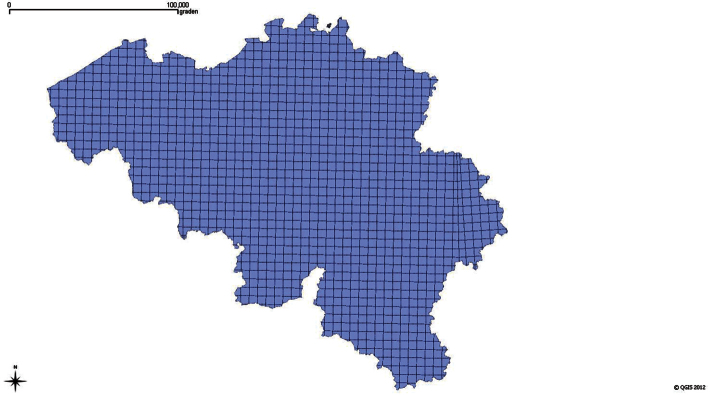
The UTM 5 Km grid of Belgium
Geographical method
The Universal Transverse Mercator Projection (UTM), an adaptation of the standard Mercator projection, uses a two dimensional Cartesian co-ordinate system to identify locations on the surface of the Earth (Wikipedia).
The UTM 5 Km (Universal Transverse Mercator Projection) raster projection divides Belgium in approximately 1200 25 km² squares (Figure 3). A representative number of UTM squares has been sampled (1125 UTM 5×5 km squares of which 659 squares with more than 10 records: see Figures 3 and 4) to complete the dataset. All the records in FORMIDABEL are georeferenced through the centroid coordinates of the corresponding UTM 5 km square. Therefore, the uncertainty on these coordinates is 3.500 meters, the distance between the centre and the corner of the UTM square.
Figure 4.
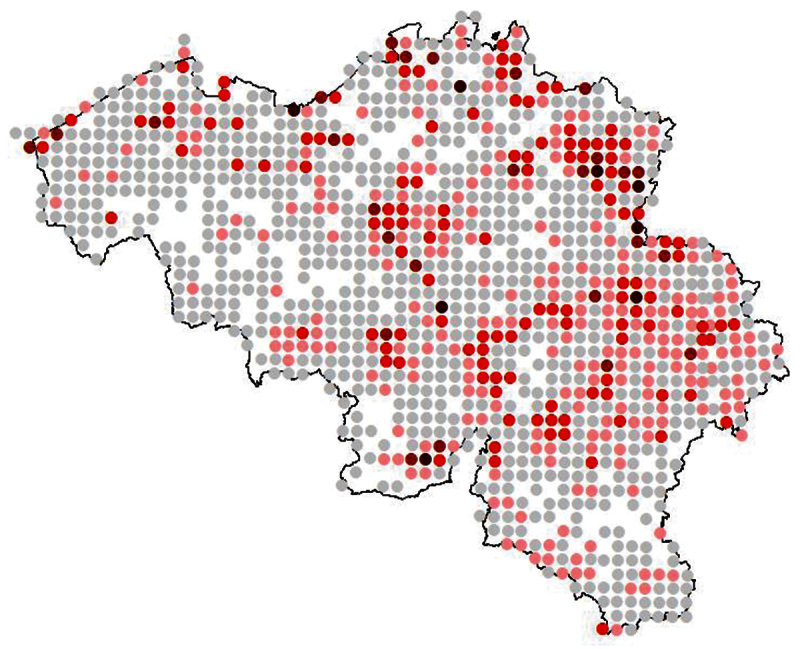
Projection of the number of records per UTM 5x5 km square (grey dots= 1-20 records, pink dots= 21-50 records, red dots= 51-150 records, dark red dots=151-300 records and black dots=301-644 records).
Ecocodes
More than half of the records are provided with a description of the microhabitat of the record locality. This allows us to give details on ecological preferences of all Belgian ant species. In FORMIDABEL we created a list of potential microhabitats for ants in Belgium. For each of these microhabitats we use a code called the “ecocode”. This code thus gives information on the habitat were the occurrence was made. Nine types of habitat and landscape were defined to collect accurate information on the habitat preference of all ant species (Dekoninck et al. 2005). These nine types are based on the EIS-code and the Flemish nature types (Vandenbussche 2002; Zwaenepoel et al. 2002). When no habitat description was available for a record (for example, with some older records) the habitat was coded as ‘Not known or not observed’. The nine main habitats we defined were: i) anthropogenic habitats, ii) dry grasslands, iii) moist grasslands, iv) forests, v) chalk grasslands, stony slopes and other rocky xerothermic habitats, vi) shrubs, vii) heathlands, viii) fens and highland bogs and ix) coastal and inland dunes.
Coordinates
49°27'0"N and 51°32'24"N Latitude; 2°28'12"E and 6°27'36"E Longitude
Temporal coverage
The oldest record in the database goes back to May 5, 1866 and the most recent records are from August 2012. The largest part of the records were obtained after 1991 (Figure 5).
Figure 5.
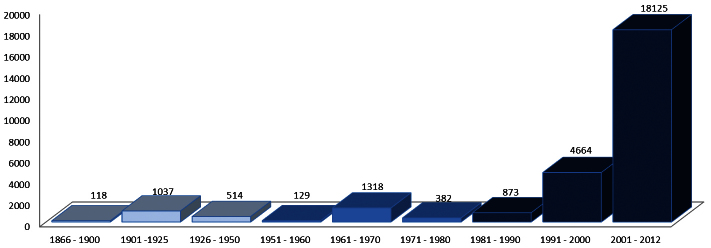
Temporal distribution of the records
Methods
Method step description:
A large portion of the occurrence data have been collected by volunteers, other records originated from several projects and research programs. The data and specimens were sent to the Belgian ant curators, and after validation, the information was incorporated in the database. The collection records “dry specimen” originate from the Gembloux “Ant” collection and the Charles Gaspar collection, the collection of the “Cercle des entomologists Liégeois”, the RBINS collection and the private collection “Roland Vannieuwenhuyse”. After revision and validation, this information was also included in the database. The literature-based records were retrieved from van Boven 1970; van Boven and Mabelis 1986; Dekoninck et al. 2006 and references therein. How the database evolved is described in the Database history section.
Sampling description: Most occurrence records originate from hand/nest sampling (42,3% of all records and mainly from Wallonia) andpitfall sampling (36,7% mainly from Flanders). The followed procedure differs from region to region. This is due to historical reasons. Some very interesting occurrence records were obtained by sifting, coloured water traps and Malaise traps (all less than 3 % of the total sampling). An extensive description of the sampling methods is provided by Schauff (2001).
Quality control description: All the records were validated by the dataset curators before being added to the FORMIDABEL database. The dataset curators also checked the determinations of the collection specimens. If needed, the determination was adapted and made consistent with modern taxonomy; Radchenko and Elmes (2010) for the genus Myrmica and Seifert (2007) for the other genera. Before the final publication of the database all the records were tested on geographical consistency by the Belgian Biodiversity Platform and corrected if necessary.
Dataset
Dataset history
At the beginning of 2001 all available records of ants in Flanders (northern part of Belgium) were brought together for the first time and several inventories were started. More than 20.000 records (for the most part gathered after 1990) were assembled in the FORMIDABEL (FORMIcidaeDAtaBELgium) database resulting in the ‘Verspreidingsatlas en voorlopige Rode lijst van de mieren van Vlaanderen; Dekoninck et al. 2003. [Distribution atlas and preliminary Red list of ant species in Flanders, Belgium]. This report contains all available distribution data for Flanders. In the southern part of Belgium (Wallonia) intensive inventorying started in 2005. Until then knowledge on the distribution of ants in Wallonia was limited. Only a few areas (Haute Fagnes, Famenne and the Viroin valley) had already been inventoried. Thanks to the good cooperation between the Polyergus and the FourmisWalBru working groups; many Belgian ant records were brought together in the FORMIDABEL database. Since then, FORMIDABEL is updated with data originating from FourmisWalBru twice a year. The FORMIDABEL dataset was then used for the creation of the “Belgian Ant Atlas”, (Dekoninck et al. 2012). In 2010 a cooperation agreement between the authors of the atlas and the Belgian Biodiversity Platform (www.biodiversity.be) was made. Together with the publication of the book, the data was published in Darwin Core Archives to GBIF (url: http://data.gbif.org/datasets/resource/14697/) and a dedicated data portal was created: www.formicidae-atlas.be.
The original FORMIDABEL database was created in Microsoft Access. Later, this database was completely imported in a relational SQL database. During this process additional data cleaning was performed; see section Quality control description. The dataflow is illustrated in Figure 6.
Figure 6.
Formidabel flowchart
Dataset description
The FORMIDABEL Darwin Core Archive is a custom made SQL view on the original version of the FORMIDABEL access database which is in the custody of the Belgian Ant working groups Polyergus and fourmisWalBru. Mind that every record in FORMIDABEL represent at least one occurrence, but primarily contains information on the presence of a species. The view only shows data that are accepted for publication. Fields given are:
id, decimalLatitude, family, basisOfRecord, stateProvince, identifiedBy, eventDate, modified, country, individualCount, scientificName, kingdom, order, geodeticDatum, genus, collectionCode, decimalLongitude, samplingProtocol, catalogNumber, phylum, recordNumber, countryCode, coordinatePrecision, language, coordinateUncertaintyInMeters, locality, specificEpithet, recordedBy, institutionCode, nomenclaturalCode, class.
The dataset contains primary biodiversity data, mostly occurrence data (Figure 7). Some records hold an indirect link to collection specimens. This link is only available in the original database.
Figure 7.
A small preview of the Darwin Core-Archive
Dataset preview
Object name: Darwin Core Archive Formidabel; Belgian Ants Database
Character encoding: UTF-8Format name: Darwin Core Archive format
Format version: 1.0
Distribution: http://ipt.biodiversity.be/resource.do?r=formidabel
Publication date of data: 2013-08-02
Language: English
Licenses of use: This work is licensed under a Creative Commons Attribution-NonCommercial-ShareAlike 3.0 Unported License. http://creativecommons.org/licenses/by-nc-sa/3.0/
Metadata language: English
Date of metadata creation: 2013-02-18
Hierarchy level: Dataset
Norms for data use and publication:
Based on http://www.canadensys.net/norms
Give credit where credit is due
As is common practice in scientific research, cite the data you are using.
Be responsible
Use the data responsibly. The data are published to allow anyone to better study and understand the world around us, so please do not use the data in any way that is unlawful, harmful or misleading. Understand that the data are subject to change, errors and sampling bias. Protect the reputation of the data publisher and clearly indicate any changes you may have made to the data.
Share knowledge
Let us know if you have used the data. It helps our participants to showcase their efforts and it helps you reach a wider audience. Inform the data publisher(s) if you have comments about the data, notice errors, or want more information.
Respect the data license
Understand and respect the data license or waiver under which the data are published. It is indicated in the rights field of every record and in the dataset metadata.
Collection data: Ant Collection Gembloux (urn:lsid:biocol.org:col:33368), Collection Charles Gaspar, Collection “Cercle des entomologists Liégeois”, RBINS Belgian Formicidae Collection (urn:lsid:biocol.org:col:35271), Private collection “Van Nieuwenhuyse”. All collections are dry prepared insect collections. The dataset does not contain unique identifiers for specimens. To track a collection specimen, the corresponding author should be contacted.
Additional information
This dataset was originally created to develop the Belgian Ants Atlas. However, the dataset can be reused for a variety of purposes. Since the link between individual data records and underlined specimens (stored in multiple collections) is not recorded, we doubt if the dataset can be used for taxonomic or systematic studies. However, this being an occurrence dataset, it can be used for understanding species richness, distribution pattern and modeling studies such as ecological niche modeling. In order to enhance the confidence of use, we have documented the metadata as well as subjected the data records to a series of quality assessment and enhancement processes as described in the earlier section quality control description.
Acknowledgments
The authors would like to thank all the contributors to this data paper. Especially all the volunteers who spend hours in the field collecting ants. We would also like to thank the Entomology Department of RBINS (Dr. Patrick Grootaert), the Cercle des Entomologistes Liégeois (P. Lays) and Gembloux Agro-Bio Tech, Unité d’Entomologie fonctionnelle et évolutive for giving us access to the collections and the Belgian Biodiversity Platform and GBIF to make this work possible. Last but not least we would like to thank Thomas Little for making sure that the English language was respected during the creation of this paper.
References
1) References cited within the metadata
- Schauff ME. (2001) Collecting And Preserving Insects And Mites Techniques And Tools Update and modified WWW version of: Steyskal GC, Murphy WL, Hoover EM (Eds) (1986) Insects and mites: techniques for collection and preservation. Agricultural Research Service, USDA, Miscellaneous Publication, Vol. 1443
- Dekoninck W, Vankerkhoven F, Maelfait J-P. (2003) Verspreidingsatlas en voorlopige Rode Lijst van de mieren van Vlaanderen. Rapport van het Instituut voor Natuurbehoud IN.R.2003.07. Brussel 191 pp.
- Dekoninck W, Maelfait J-P, Vankerkhoven F, Grootaert P. (2005) Remarks on the distribution and use of a provisional red list of the ants of Flanders (Formicidae, Hymenoptera). In: Procter D, Harding PY. (Eds). JNCC Report No.367 Proceedings of IN Cardiff 2003, Red Lists for Invertebrates: their application at different spatial scales – practical issues, pragmatic approaches: 74-85
- Dekoninck W, Maelfait J-P, Vankerkhoven F, Baugnée J-Y, Grootaert P. (2006) – An update of the checklist of the Belgian ant fauna with comments on new species for the country (Hymenoptera, Formicidae). Belgium Journal of Entomology 8: 27-41 [Google Scholar]
- Dekoninck W, Igance D, Vankerkhoven F, Wegnez P. (2012) Verspreidingsatlas van de mieren van België/Atlas des fourmis de Belgique. Bulletin SRBE/KBVE, 148 (III): 95–186pp.
- Seifert B. (2007) Die Ameisen Mittel-und Nordeuropas - Lutra Verlags- und Vertriebgesellschaft. Klitten, 368 pp.
- Radchenko AG, Elmes GW. (2010) Myrmica ants (Hymenoptera: Formicidae) of the Old World. Fauna Mundi, Vol. 3, 789 pp.
- Vandenbussche V. (2002) Systematiek van natuurtypes voor de biotopen heide, moeras, duin, slik en schor: deel 1: Inleiding. Brussels, Instituut voor Natuurbehoud.
- Zwaenepoel A, T’Jollyn F, Vandenbussche V, Hoffmann M. (2002) Systematiek van Natuurtypes voor de biotoop grasland. Brugge & Brussels, WVI & Instituut voor Natuurbehoud.
2) References used to develop the dataset
- Bondroit J. (1909) Les fourmis de Belgique. Annales de la Société royale belge d’Entomologie 1909, 53: 479–500.
- Bondroit J. (1910) Compte rendu d’une excursion aux environs de Hockai. Annales de la Société royale belge d’Entomologie, 54: 231-232 [Google Scholar]
- Bondroit J. (1911) Contribution à la fauna de Belgique, Notes diverses. Annales de la Société royale belge d’Entomologie, 55: 8-13 [Google Scholar]
- Bondroit J. (1912) Fourmis des Hautes Fagnes. Bulletin et Annales de la Société royale belge d’Entomologie, 56: 351-352 [Google Scholar]
- Bondroit J. (1918) Les Fourmis de France et de Belgique. Annales de la Société d’Entomologie de France, 87: 1-174 [Google Scholar]
- Cammaerts R, Cammaerts M-C. (1988) Four ants (Hym.: Formicidae) new to the Belgian Fauna. Entomolgist’s Record, 100: 37-38 [Google Scholar]
- De Biseau J-C, Couvreur J-M. (1994) Fourmis (Formicidae). Faune de Belgique. Institut royal des Sciences naturelles de Belgique, 56 pp.
- Dessart P, Cammaerts R. (1995) Recaptures d’Hypoponera punctatissima en Belgique (Hymenoptera Formicidae Ponerinae). Bulletin S.R.B.E./K.B.V.E. , 131: 487-489 [Google Scholar]
- Gaspar C. (1970) Hymenoptera Formicidae: cartes 143–164. In Atlas Provisoire des Insectes de Belgique, cartes 101–200. Edité par J. Leclercq, Faculté des Sciences Agronomiques de l’Etat, Zoologie générale et Faunistique, Gembloux.
- Gaspar C. (1970) Hymenoptera Formicidae: cartes 15–30. In Atlas Provisoire des Insectes de Belgique, cartes 1–100. Edité par J. Leclercq, Faculté des Sciences Agronomiques de l’Etat, Zoologie générale et Faunistique, Gembloux.
- Gaspar C. (1971) Hymenoptera Formicidae: cartes 203–216. In Atlas Provisoire des Insectes de Belgique, cartes 201–300. Edité par J. Leclercq, Faculté des Sciences Agronomiques de l’Etat, Zoologie générale et Faunistique, Gembloux.
- Schoeters E, Vankerkhoven F. (2001) Onze mieren. Educatie Limburgs Landschap, Heusden-Zolder, 175 pp. [Google Scholar]
- van Boven JKA. (1947) Liste de détermination des principales espèces de Fourmis belges (Hymenoptera: Formicidae). Bulletin S.R.B.E./K.B.V.E. , 83: 163-19020244534 [Google Scholar]
- van Boven JKA. (1949) Notes sur la faune des Hautes Fagnes en Belgique. Bulletin S.R.B.E./K.B.V.E. , 85: 135-14318136084 [Google Scholar]
- van Boven, JKA. (1970) Vliesvleugelige insecten - Hymenoptera, Angeldragers - Aculeata, Mieren - Formicidae. Wetenschappelijke Mededelingen van de Koninklijke Nederlandse Natuurhistorische Vereniging, 30: 52 pp.
- van Boven JKA, Mabelis AA. (1986) De mieren van de Benelux. Wetenschappelijke Mededelingen van de KNNV 173, 64 pp.
3) Puplications based on this dataset
- Dekoninck W, Igance D, Vankerkhoven F, Wegnez P. (2012) Verspreidingsatlas van de mieren van België/Atlas des fourmis de Belgique. Bulletin SRBE/KBVE, 148 (II): 94 pp.
- Dekoninck W, Maelfait J-P, Vankerkhoven F, Baugnée J-Y, Grootaert P. (2006) An update of the checklist of the Belgian ant fauna with comments on new species for the country (Hymenoptera, Formicidae). Belgium Journal of Entomology, 8: 27-41 [Google Scholar]



